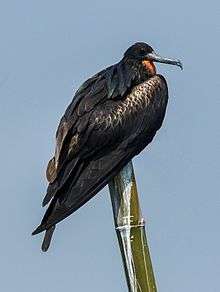Christmas frigatebird
| Christmas frigatebird | |
|---|---|
 | |
| Male at Jakarta Bay, Indonesia | |
| Scientific classification | |
| Kingdom: | Animalia |
| Phylum: | Chordata |
| Class: | Aves |
| Order: | Suliformes |
| Family: | Fregatidae |
| Genus: | Fregata |
| Species: | F. andrewsi |
| Binomial name | |
| Fregata andrewsi Mathews, 1914 | |
The Christmas frigatebird or Christmas Island frigatebird (Fregata andrewsi) is a seabird of the frigatebird family Fregatidae which is endemic to Christmas Island in the Indian Ocean.
The Christmas frigatebird is a large lightly built seabird with brownish-black plumage, long narrow wings and a deeply forked tail. It has a wingspan of around 2.15 m (7.1 ft). The male has an egg shaped white patch on its belly and a striking red gular sac which it inflates to attract a mate. The female is slightly larger than the male and has a white breast and belly. They feed on fish taken in flight from the ocean's surface (mostly flying fish), and sometimes indulge in kleptoparasitism, harassing other birds to force them to regurgitate their food. The species is listed as critically endangered by the International Union for Conservation of Nature.
Taxonomy
The Christmas frigatebird was once considered to belong to the species Fregata aquila but in 1914 the Australian ornithologist Gregory Mathews proposed that the Christmas frigatebird should be considered as a separate species with the binomial name Fregata andrewsi in honour of the English paleontogist Charles Andrews.[2] Of the four other species within the Fregata genus, genetic analysis has shown that the Christmas frigatebird is most closely related to the great frigatebird.[3]
Description
The Christmas frigatebird measures 89–100 cm (35–39 in) in length, has a wingspan of 205–230 cm (81–91 in) and weighs around 1,550 g (3.42 lb).[4] The adult male of this species is easily identified, since it is all black except for a white belly patch. Other plumages resemble those of the smaller lesser frigatebird, but have whiter bellies and longer white underwing spurs.
Status
The Christmas frigate is endemic to Christmas Island and breeds in only four main nesting colonies. In 2003 there were 1,200 breeding pairs but as frigatebirds normally breed every other year, the total adult population was estimated to be between 3,600 and 7,200 individuals.[5] The species has a small population and breeds on just one island. It is therefore listed by the International Union for Conservation of Nature as "Critically Endangered".[1]
References
- 1 2 BirdLife International (2013). "Fregata andrewsi". IUCN Red List of Threatened Species. Version 2013.2. International Union for Conservation of Nature. Retrieved 26 November 2013.
- ↑ Mathews, GM (1914). "On the species and subspecies of the genus Fregata". Australian Avian Record. 2 (6): 120 (117–121).
- ↑ Kennedy, Martyn; Spencer, Hamish G (2004). "Phylogenies of the frigatebirds (Fregatidae) and tropicbirds (Phaethonidae), two divergent groups of the traditional order Pelecaniformes, inferred from mitochondrial DNA sequences". Molecular Phylogenetics and Evolution. 31 (1): 31–38. doi:10.1016/j.ympev.2003.07.007.
- ↑ Orta, J; Garcia, EFJ; Kirwan, GM; Boesman, P. "Christmas Frigatebird (Fregata andrewsi)". In del Hoyo, J; Elliott, A; Sargatal, J; Christie, DA; de Juana, E. Handbook of the Birds of the World Alive. Barcelona: Lynx Edicions. Retrieved 30 November 2014.(subscription required)
- ↑ James, David J; McAllan, Ian AW (2014). "The birds of Christmas Island, Indian Ocean: A review" (PDF). Australian Field Ornithology. 31 (Supplement): S24 Table 3, S64–S67.
Further reading
- James, David J (2004). "Identification of Christmas Island, Great and Lesser Frigatebirds" (PDF). BirdingASIA. 1: 22–38.
External links
| Wikispecies has information related to: Fregata andrewsi |
| Wikimedia Commons has media related to Fregata andrewsi. |
- BirdLife International species factsheet
- Internet Bird Collection: photos, videos and audio recordings
- Audio recordings from xeno-canto
